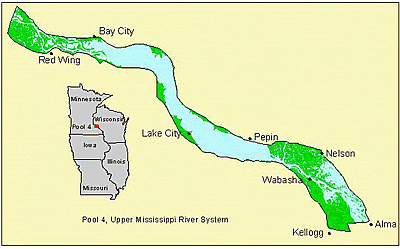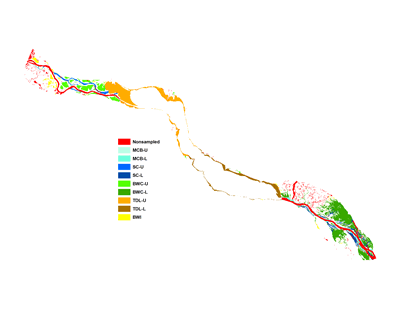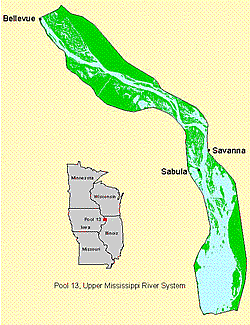Aquatic Vegetation
Study Areas for the Long Term Resource Monitoring Program's Aquatic Vegetation Sampling
|
|
||||
|
|
||||
|
|
||||
|
||||
|
|
||||
|
||||
|
|
||||
|
Navigation Pool 26 study area includes water bodies along the Upper Mississippi River from Lock and Dam 25 (Winfield, Missouri) to Lock and Dam 26 (Alton, Illinois) 63 km (39 river miles) long and the lower Illinois River from its confluence with the Mississippi River north to Illinois River mile 12. This reach of the two rivers is bordered by high bluffs on the Illinois side and low elevation floodplain on the Missouri side. The reach encompasses 9,500 ha (23,700 acres) of aquatic habitat. Presently, most of the backwaters of the lower Illinois River are isolated from the river by low levees so as to decrease sedimentation and allow management for waterfowl. Likewise, many of the secondary channels of the Mississippi River are isolated from the river on the upstream side to create backwaters and to reduce sedimentation. |
||||
|
La Grange Pool on the Illinois River is about 130 km (80 river miles) long and encompasses 10,750 ha (26,500 acres) of aquatic habitat. It is bounded by Peoria Lock and Dam to the north and La Grange Lock and Dam to the south. This reach has the highest proportion of backwaters, except for Pool 4, but these backwaters are highly degraded by excessive sedimentation over the last 150 years. Many backwaters are isolated by low levees to enhance waterfowl habitat management. Major tributaries include the Sangmon, Mackinaw, and LaMoine Rivers. |
||||
Content manager: Danelle Larson
Page Last Modified: April 17, 2018









